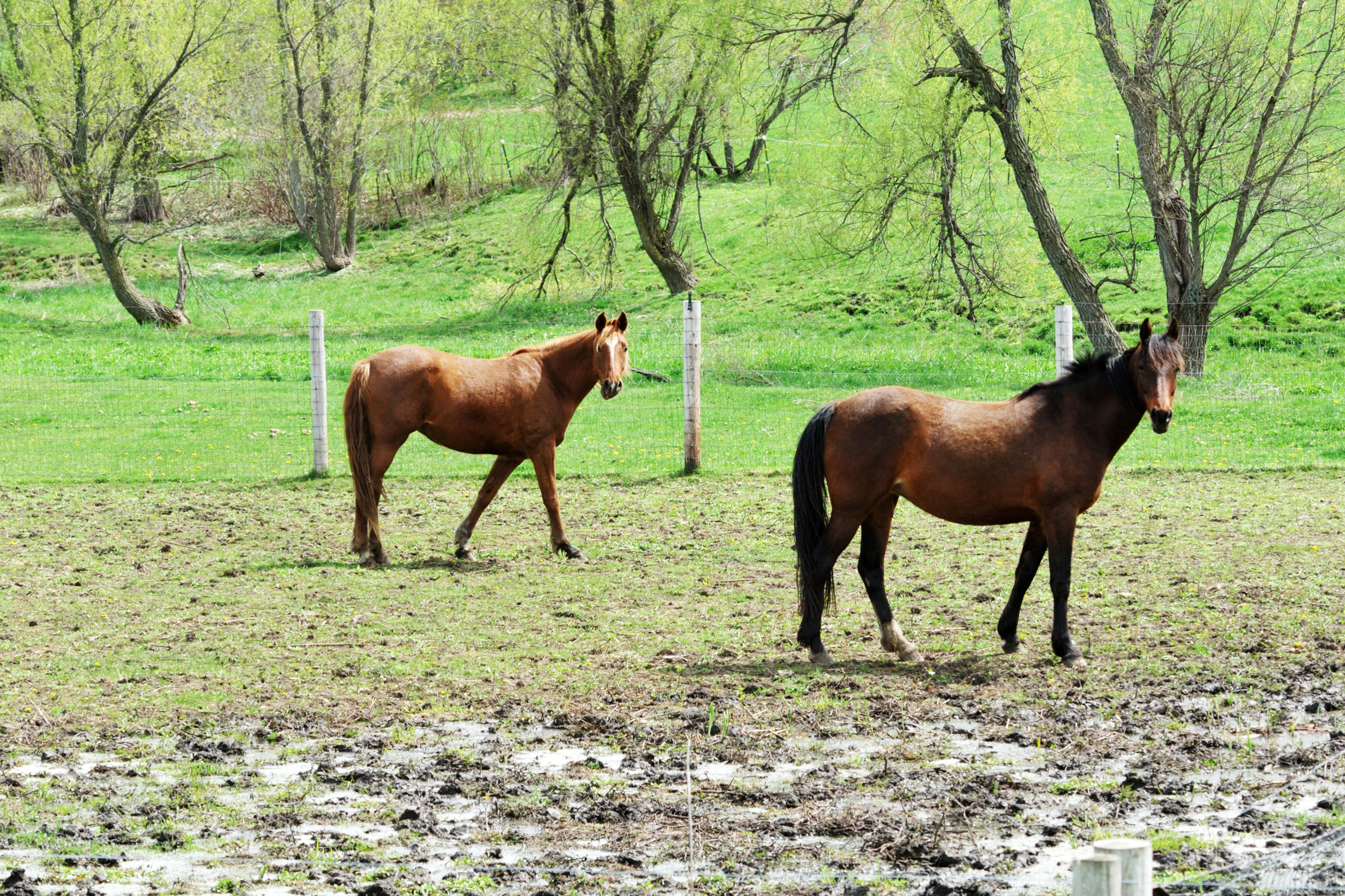 Drainage problems are the reason horse farms get mud in paddocks or fields.
Drainage problems are the reason horse farms get mud in paddocks or fields.“Drainage problems are the main reason we get mud,” said Laura Kenny, MS, who served as the Program Associate in Animal Science, Rutgers University. “These problems may include things like compacted soil (the water doesn’t filter on down through it), a high water table, a low spot in a field, or broken drainage systems. We often see a lack of vegetation in muddy areas. This could be a result of water flooding and killing plant roots, or it could contribute to the mud problem if there are no plant roots (sod) to take up excess water.”
Links in articles are part of an Amazon Affiliate program that provides income to support this brand. Links are chosen by our editors.
There is no sod to keep horse feet from sinking into the mud. Plant roots (sod) help anchor the soil and absorb water that would otherwise become mud.
If horses are confined in the muddy area, remove all manure and feed from the ground as often as possible.
Equine business owners can create an Amazon Business Account.
“As manure and feed (including hay) break down, they become organic matter in the soil. This acts like a sponge and holds water, contributing to mud problems,” said Kenny.
By contrast, plain soil allows water to run down through it, keeping the top layer drier, said Kenny.
She suggested keeping feed off the ground (use above-ground feeders or rubber mats) and picking up what does fall to the ground.
Clean out manure from loafing areas regularly. Organic matter is good for soil in a pasture, but contributes to mud in a corral or pen that has no grass. If areas in a pasture are becoming muddy, add some grass seed to those beaten-out spots so the roots will hold the soil together and suck up water.
Many horsemen designate a “sacrifice lot” to use during muddy seasons, to preserve pasture grass.
“Keep horses in the sacrifice lot when grazing conditions are too wet, or during drought or winter,” advised Kenny. “During the grazing season, rotate the horses through several smaller pastures, giving each pasture several weeks to rest and regrow until forage is 6-8 inches tall. This keeps plant density high, which reduces mud.”
You don’t want horses on your pastures when they are very wet because hooves cut down through the wet sod and destroy it.
If you have an area that gets really muddy, look around the farm to see if rainwater or snowmelt is draining into that area from somewhere else.
“You may be able to do something to redirect that water. A drain line can be expensive, but you could create a ditch or berm to keep the water from coming into the pen. Also make sure any gutters or downspouts from barn and shed roofs are taking the water into a desired place instead of into your horse pen,” she said.
Sign up now for Amazon Prime 30-day Free Trials, a membership program that offers special benefits including: Instantly watch thousands of movies and TV episodes; Borrow Kindle books; Get unlimited FREE two-day shipping (no minimum order size). Learn more.
Make sure the water from a shed roof can drain away from the shed or pen. The diverted water should drain to a large grassy area to infiltrate back into the ground, rather than flowing off the property or into a waterway.
“Try to direct the run-off away from where the horses will be,” said Karen Waite, Extension Horse Specialist, Michigan State University. “Often these gutters just route the water into the turnout lots, if the barn has gutters at all. Some don’t, and the water simply runs off the roof and creates a problem.”
You may want to direct the water into a specific area where there are no horses.
“One of the biggest problems is that we tend to put pastures and turnout areas in low spots on horse properties, and then wonder why they are muddy,” said Waite.
The barns, hay sheds and other buildings are generally built on the higher, well-drained areas, leaving the low spots for pens and pastures.
“Site selection in advance when laying out a farm can help with mud problems,” added Waite. “Don’t put your turnout lots in the lowest spots, if you can avoid it. If you know you will have a high-traffic area (around feeders, waterers, etc.), try to put these in the higher areas of the turnout pen(s) as opposed to a low area.”
A person also needs to think about forage plants in a pasture and stocking rate, to avoid overuse that would beat out the plants and create muddy areas.
“If you can keep grass in an area, it will be less muddy in the future. A good sod can be very helpful.Think about where the most horse traffic will be, and what you can do to elevate those areas and keep them well drained,” she said.
When the weather is nice and there are no moisture issues, we generally don’t think about these issues, but we need to be thinking of what it will be like in the wet seasons.
“We often don’t worry about it in July, but we may have big problems in November or March! Those are my two least favorite months here in Michigan because of the mud issues,” Waite noted.



